Diego, in his recent comment here, writes:
All farmers would love to have a green pasture, with lots of different animals and species growing on it, in a harmonious bioregion, but this practice is not economically viable for many, until they free themselves from the shackles of multinationals.
Unfortunately we don’t have time…
Time, of course, is the ultimate intangible commodity. The drive to produce more in less time, is, arguably, how we got ourselves into this absurd mess in the first place.
To free up time; to be able to stop for a minute, look around and consider whether what I’m doing is done in the most intelligent manner — this really is the most rare commodity I have.
In the days leading up to the exhibition opening, it was very difficult to think and work mindfully. When you’re hurtling towards a deadline, the main thing on your mind is that “everything has to be perfect” as the moment of the great unveiling arrives. Thus in terms of time, the launch-moment is more important than the lead-up period. The lead-up is simply the means to an end: disposable time.
I’ve seen it on dozens of occasions, setting up art exhibitions. We all race around like chickens expending far more energy than necessary; we buy more supplies than we need from the hardware store, because we “don’t have time” to go back to the shops if we’ve forgotten something; we leave a big trail of detritus behind us, to be cleaned up (or chucked out) later on; we beg favours from friends we hope to pay back some day; we operate out of panic rather than calm absorbtion.
In short, we borrow time from the future.
(A rare political aside: this panicked hurtling towards the exhibition opening does seem to share something with the wasteful, shortsighted race by our mitey democratic leaders and their parties towards the recent election… and hopefully that’s the last I’ll have to say on that matter.)

[A more mindful way to use solar energy…I spotted this fellow catching some z’s on the gloriously sunny front lawn of the MCA last Friday…]

Of course, I don’t want to go all holier-than-thou. Nor do I want to suggest that we totally overhaul our model of putting on exhibitions; getting rid of deadlines altogether (that suggestion will perhaps come later on in my Audit). Deadlines can be thrilling to work towards, and they do ensure that we actually “get something done”. Getting things done generates “a sense of achievement”, which we humans seem to need. Deadlines can also lend a certain clarity to our otherwise murky everyday activities.
For now, it would simply be interesting if we could take a deep breath and think beyond the deadline. What happens tomorrow, next week, next month, next year? What’s happening right now? Which of these times is any more important than any other?
I’m going to now run through a few teeny-tiny case studies which I have noticed in the last day or two, where “time was of the essence” to such an extent that the deadline was prioritised over intelligent use of resources.
I do not offer these as a way of criticising or condemning those involved. In fact, in each case, the information was volunteered by museum staff or exhibiting artists who already felt conflicted about what they were doing, but were locked into a trajectory bound by the deadline.
Forgive me, and please, by all means correct me, if the stories I re-tell below are not accurately narrated…
Case Study One: The Short-Term Wall Labels
Here’s Emma, holding a stack of exhibition wall labels.
These are laser-printed on photocopy paper up in the office, then they are affixed (perhaps with spray adhesive? or gluestick? or are they printed on stickyback paper?) to a large sheet of foamcore, before being carefully cut to produce individual rectangles.
And here’s a bin of the inevitable offcuts:
The resulting labels are clean, crisp, three-dimensional blocks which lend a certain authority to the data they carry: the artist’s name, the title of the work, the year, dimensions, and so on. As well as being basic essential info, they legitimise the work on show, in a way that a hand-scrawled text on the back of a re-used envelope stuck up with a bit of blu-tak never could.
Once printed and cut, the block-mounted labels are then stuck around the gallery in the appropriate positions adjacent to the work they name, using double-sided tape.
Now, I believe it’s normal for the museum to dispose of these labels after the show closes. If I’m not mistaken, the act of removing the label from the wall (the double-sided tape is quite strong) causes the foamcore substrate to bend and dent, rendering them useless for future service as labels.
So! What makes our current deadline-hurtling moment interesting? As she works, cutting and measuring and pasting, Emma already knows that she will have to scrap and re-make all these labels, next week.
Why? Because after the exhibition opens, there will finally be time to edit and approve the “extended texts” which accompany the basic data on the labels. For aesthetic reasons, it is normal to have the basic data and the extended texts combined on the same wall label. Thus, the old ones will be taken down and thrown away, and the new ones will have everything all together on one nice clean white foamy tablet.
Case Study Two: The Hoarding-As-Art
In all the rushing around to set up the show, I would every so often bump into one of the other artists, and we’d have a polite chat about our respective projects, and express the hope to spend a bit more time together “soon”. After these meetings, I’d speed off to my own list of tasks, feeling vaguely irritated that I did not have more time to be there, then. However, occasionally some of the information we exchanged would stick in my head, rising to the surface later. One such occasion was when I met the artist Lyndal Jones.
Lyndal’s piece in the exhibition is a kind of “whispering wall”, featuring the voices of the townspeople of Avoca, in country Victoria, and their thoughts on climate change. The idea, she told me, was to embed these voices into the plywood hoarding that was to be erected to protect the public from the newly established building site adjacent to the MCA. This is where work has begun on the MCA extension.
However, as luck wouldn’t have it, the builders in their wisdom decided they didn’t really need a plywood hoarding just yet. They just set up a cyclone fence covered with blue mesh and left it at that. So the MCA had to construct a hoarding especially, in order to present Lyndal’s work in time for the opening.
Here’s Garth, MCA preparator and zen master extraordinaire, working on the “hoarding”, in front of the blue mesh fence:
And here you can see a bit more of the “behind the scenes”:
Lyndal told me that the builders were still planning to put up a “proper” hoarding, but that this would not be done until next week. I’m not sure what will happen next: will the artwork be re-sited to the real hoarding, or will it remain as an extra layer in front? Stay tuned!
[UPDATE – I’ve just spoken to Tony (more on him immediately below) who said that the builders will be putting up a proper hoarding behind the artwork hoarding. Thus the artwork will remain as-is til the end of the show…]
Case Study Three: The Scandalous Plastic Bag Throwout
Well, this isn’t a very dramatic case. Unless you were one of the volunteers who slaved away for weeks gathering and folding plastic bags for Lauren Berkowitz’s plastic bag wall.
Here’s Tony, boss and king of all the preparators, having just returned from an expedition to the skip to retrieve “excess” plastic bags which had, somehow, bewilderingly, been thrown away after the conclusion of Lauren’s installation. I guess somebody thought they just looked like garbage.
I should note that this was about 8pm on Thursday, the night before the exhibition opened. Good old Tony, he’s so cheerful even after having to dumpster-dive his own bin when he really should have been at home watching Catalyst.
Of course, it’s important to keep excess plastic bags for Lauren’s work – not only because they represent hundreds of hours of embodied energy in the collecting, folding, and fluffing. But also because of the inevitable repairs and tweaks which the work will require. You need some spares!
(Incidentally, this reminds me a bit of Gustav Metzger’s rubbish-art throwout gaffe a few years ago at the Tate Britain. More on Metzger in this blog soon, if I remember… He’s an interesting case-study in himself…)
Case Study Four: The Desire to Recycle is Strong in Him.
This final study doesn’t really have to do with the exhibition opening deadline. But it fits within the spirit of these rather minor and perhaps pernicketty exposés, as well as with the fact that all these discoveries arose by chance.
So, on Saturday, there were some artists talks in the gallery. All the artists were given plastic bottles of water(!) to lubricate their dry throats before speaking. After the talks, I was hanging out with Ian and Dan from FutureFarmers, auditing their project. We decided to pop out to get something to eat. As we were leaving, Ian wanted to throw away his plastic water bottle. Here he is at the exit to the MCA:
But hang about! This ain’t no recycling bin. He looked around – there was none to be found. He went to the front reception, where the lovely visitor services officer on duty accepted his bottle and placed it in the recycling bin, hidden cunningly behind the desk.



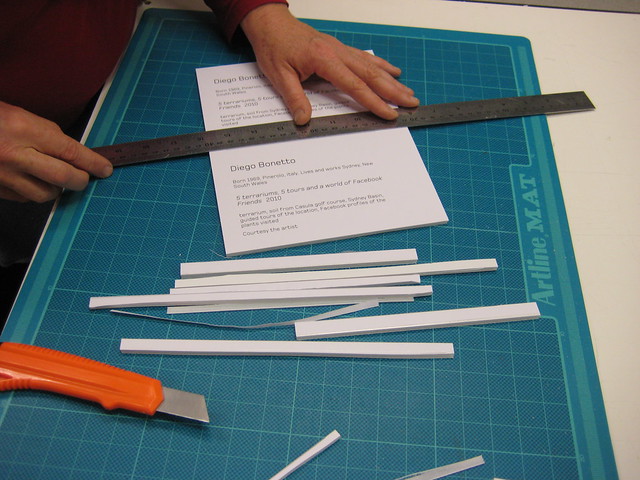
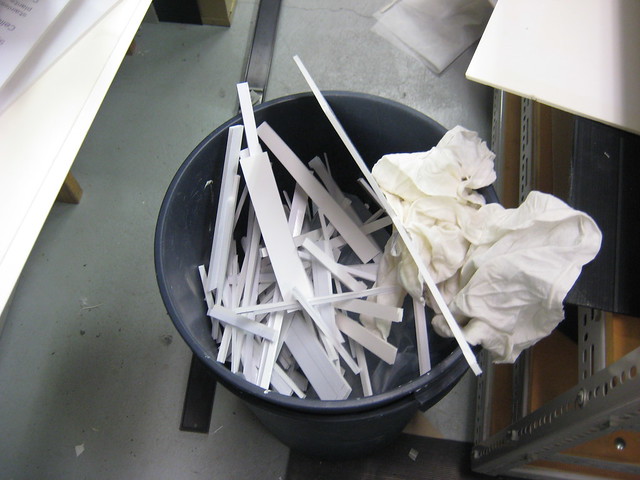

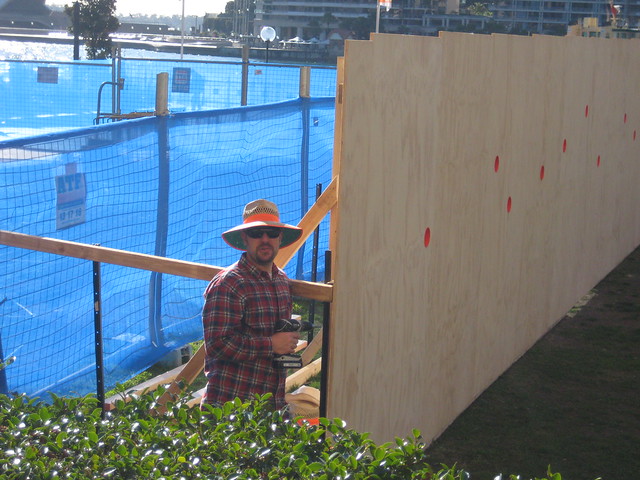

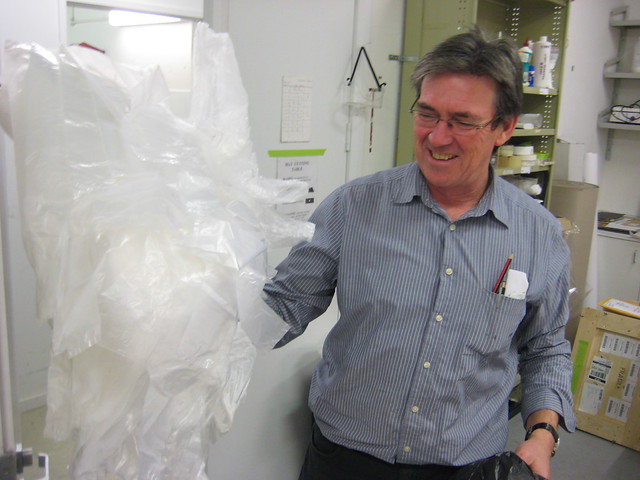
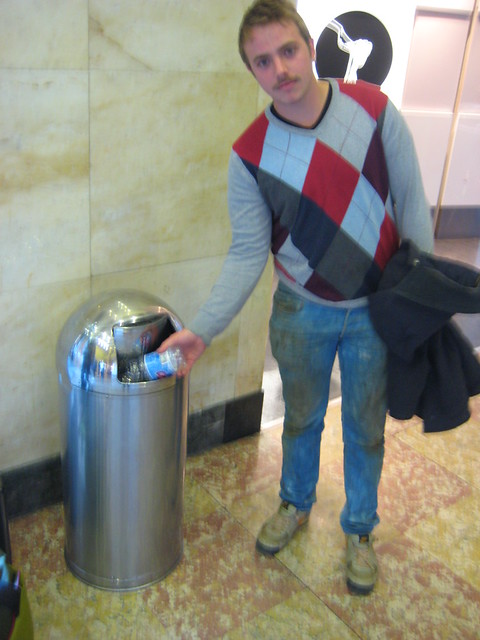
A small update – An unnamed source at the front desk informed me today that, having read this blog entry after work yesterday, she had to correct me on the final case study.
There is in fact no recycling bin behind the reception desk. In fact, according to my source, the visitor services officer in question took it upon herself to relocate Ian’s plastic bottle to the recycling bins up in the MCA staff kitchen… She agreed that it seems odd that there is no publically available recycling system…
Another small update – Noticed this today… Just out the front of the MCA lawn, you can satisfy your desire to recycle:
Hi Lucas,
I thought you and your readers might like this article I just read in the New York Times on Bad Art and Rubbish.
It’s a pity they don’t mention how Bad Art could be seen in terms of sustainability — but then again, maybe bad art like bad food makes more waste? I don’t think so from what you are saying above.
Here’s the link: http://www.nytimes.com/2010/09/03/arts/design/03badart.html?ref=arts
Anna.
Thanks Anna, I loved that article.
I’ve dreamed of visiting the Museum of Bad Art since I first heard of it a few years ago.
Of course, when these folks say “bad” they really mean “so bad it’s good”, in other words: good.
Usually in these cases, what’s really going on is a sort of “slum connoisseurship” – a recuperation of “rubbish” (in this case, outcast, forgotten, abandoned paintings) by savvy hipster types (or by pointy headed outsider-art experts!) I guess it’s a form of recycling!
If we can learn to love hitherto unloved objects that are already in the world, it will perhaps at least slow the journey of those objects into landfill…
Then, of course, there’s really bad art… but perhaps that’s another story?
Just picking up on one of the case studies in the blog entry above – the one about the wall labels. This time, the MCA decided NOT to tear down all the labels and replace them with fully integrated ones. Rather, they simply added the extra text as a new label next to the existing one. A minor victory for the audit!